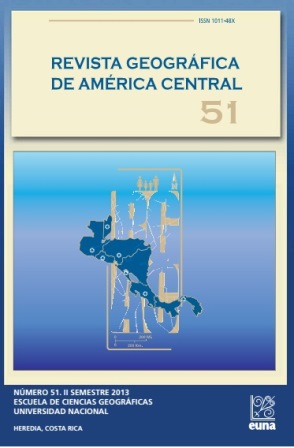CLASSIFICATION OF THE COASTLINE ACCORDING TO THE DEGREE OF ENVIRONMENTAL SENSITIVITY TO OIL SPILLS IN THE GULF OF NICOYA, COSTA RICA, FOR THE YEAR 2012
Keywords:
Oil spills, environmental sensitivity, immediate response measures, Gulf of Nicoya, Costa Rica, National Oceanic and Atmospheric AdministrationAbstract
This work is an analysis of the environmental sensitivity of coastal and marine areas in the Gulf of Nicoya oil spill. In response to a lack of tools and technical-scientific studies at the national level to provide measures and strategies to reduce and minimize the impacts of such spills, this research uses the methodology for the creation of an Environmental Sensitivity Index (ESI) developed by the National Oceanic and Atmospheric Administration (NOAA) of the United States, which considers three variables: coastal geomorphology and biological and anthropic use resources. It has been calibrated and adjusted to the characteristics of the Gulf of Nicoya. The results obtained determine the classification of the coastline according to the degree of sensitivity to a spill, and therefore the immediate response measures.References
Alvarado. M, Flores. M y Miranda. P. (2011). Propuesta de zonificación turística como modelo de planificación territorial para comunidades del Golfo de Nicoya. Revista Geográfica de América Central. Nº 46. I Semestre 2011. pp. 87–107.
Bergoeing, J. P. (1998). Geomorfología de Costa Rica. San José: Instituto Geográfico Nacional.
Bergoeing, J. P. y Brenes, L. (2007). Práctica de la Geografía. Cartago: Editorial Tecnológica de Costa Rica.
Bergoeing, J.P. y Vargas–Ulate, G. (2010). Diccionario de la Geografía. Cartago: Editorial Tecnológica de Costa Rica.
Castro, E, Jiménez, L y León, S. (2000). Valoración económico – ecológica de la degradación de las aguas del Golfo de Nicoya. (Resumen Ejecutivo). CINPE / UNA.
Denyer, P. y Kussmaul, S. (Eds.) (2000). Geología de Costa Rica. Editorial Tecnológica de Costa Rica. Cartago.
Flores Silva, E. (2004). Geografía de Costa Rica. Ed. 8ta. San José: Editorial Universidad Estatal a Distancia.
Esquivel Jiménez, J. (2011). Sensibilidad ambiental ante derrame de hidrocarburos entre la desembocadura del río Matina y Puerto Limón, Costa Rica. Proyecto de Licenciatura, Universidad de Costa Rica,
Costa Rica.
International Petroleum Industry Environmental Conservation Association (IPIECA). Asociación Regional de Empresas de Petróleo y Gas Natural en Latinoamérica y el Caribe (ARPEL). (1990-2007). Preparación y respuesta ante derrames de hidrocarburos. Obtenido el 10 deoctubre del 2011, desdehttp://www.ipieca.org/sites/default/files/publications/OSR_Summary_Spanish.pdf.
Instituto Costarricense de Turismo. (Costa Rica). Oferta de Hospedajes
en los cantones de Nicoya, Nandayure, Cañas, Bagaces, Abangares, Puntarenas, Esparza, Garabito y Parrita. Escala 1: 5000. Proyección Transversal de Mercator CRTM05. San José: Instituto Costarricense de Turismo, 2012.
Instituto Geográfico Nacional. (Costa Rica). Hojas cartográficas Abangares, Barranca, Berrugate, Cabuya, Chapernal, Golfo, Herradura, Parrita, Río Arío, Tárcoles, Tambor, Venado. Escala 1: 50 000. Proyección Cónica Conforme de Lambet. San José: Instituto Geográfico Nacional, 1983-1989.
Instituto Geográfico Nacional. (Costa Rica). Hojas cartográficas San José, Nicoya y Quepos. Escala 1: 200 000. Proyección Cónica Conforme de Lambet. San José: Instituto Geográfico Nacional, 1985.
Atlas digital de Costa Rica. Escala 1:200 000. Proyección Cónica Conforme de Lambet. Cartago: Instituto Tecnológico de Costa Rica, 2008.
Martínez Guingla, R. (2003). Mapas de sensibilidad ambiental, una herramienta para el diseño una de infraestructura costera y portuaria. Departamento de Oceanografía y Clima. Obtenido el 13 de octubre del 2011, desde http://www.bvsde.paho.org/bvsaidis/ ecuador10/ coste.pdf.
Monge Nájera, J. (2004). Historia Natural de Guanacaste. San José: Editorial Universidad Estatal a Distancia. Moraga, G (2011). Geografía cultural e identidad territorial: el caso de la comunidad de Cabuya, distrito de Cóbano, Puntarenas, 2009. Revista Geográfica de América Central. Nº 46. I Semestre 2011. pp. 131–154.
National Oceanic and Atmospheric Administration (NOAA). (2007). Environmental Sensitivity Index Map. Obtenido el 18 de agosto 2011,
desde http://response.restoration.noaa.gov/esi.
Nielsen Muñoz, V. y Quesada Alpízar, M. (Eds.). (2006). Informe Técnico: Ambientes Marino Costeros de Costa Rica. Centro de Investigación en Ciencias del Mar y Limnología (CIMAR) y The Nature Conservancy (TNC). San José.
OMI-RAC/REMPEITC-Caribe. (2010). Regional Marine Pollution Emergency, Information and Trining Center. Annex B Caribbean island OPRC Plan National Focal Points and Country Profiles. Obtenido el 01 agosto 2011, desde http://cep.unep.org/racrempeitc/ regional-oprc-plans/annex-b-country-profiles-focal-points/view.
Sistema Nacional de Áreas de Conservación (SINAC). 2010. Mapa de
Áreas Silvestres Protegidas de Costa Rica. Proyección WGS84. San José: USIG-INBIO.
The International Tanker Owners Pollution Federation Limited (ITOPF).
(2010). Oil Tanker Spill Statistics. Obtenido el 01 setiembre 2011, desde http://www.itopf.com/-information%2Dservices/ data%2Dand%2Dstatistics/statistics/
Unidad Ejecutora del Proyecto Regularización Catastral y de Registro.
(Costa Rica). Cartografía base: línea de costa, curvas de nivel, ríos
y carreteras. Escala 1: 5000. Proyección Transversal de Mercator
CRTM05. San José: Asamblea Legislativa, 2007.
Unidad Ejecutora del Proyecto Regularización Catastral y de Registro.
(Costa Rica). Fotografías aéreas del área del Golfo de Nicoya. Escala
: 25000. Proyección Transversal de Mercator CRTM05. San
José: Asamblea Legislativa, 2007.
Downloads
How to Cite
Issue
Section
License
Proposed policy for journals offering Open Access
Authors publishing their works in the Journal acknowledge and agree to the following terms:
a) Authors retain the copyrights to their works and guarantee the Journal the right to be the first to publish their works, under the Creative Commons License Attribution-NonCommercial-ShareAlike 4.0 International, CC BY-NC-SA 4.0 International (https://creativecommons.org/licenses/by-nc-sa/4.0/deed.es), which allows others to share works upon complying with the acknowledgment of authorship and mention of the Journal as the original publisher of the work.
b) Authors are permitted to separately establish additional agreements for the non-exclusive distribution of the official edition of the work published in the Journal (for example, authors may desire to place the work in an institutional repository or incorporate it into a book that is to published elsewhere) so long they acknowledgment to recognize the Journal as the original publisher. The aforementioned additional agreements must respect the terms of the non-profit character and sharing philosophy of the original license (CC BY-NC-SA 4.0 International, https://creativecommons.org/licenses/by-nc-sa/4.0/deed.es).
c) Authors are encouraged to archive the post-print or editor/PDF version in Open Access repositories.






 REVGEO is licensed under https://creativecommons.org/licenses/by-nc-sa/4.0/deed.es
REVGEO is licensed under https://creativecommons.org/licenses/by-nc-sa/4.0/deed.es
.svg_4.png)

_(1).png)
_(1)_(1)_(1)_1.png)
(2)(1)(1)(1).png)
